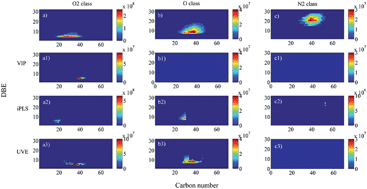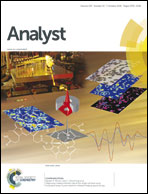Petroleomics by electrospray ionization FT-ICR mass spectrometry coupled to partial least squares with variable selection methods: prediction of the total acid number of crude oils
Abstract
Negative-ion mode electrospray ionization, ESI(−), with Fourier transform ion cyclotron resonance mass spectrometry (FT-ICR MS) was coupled to a Partial Least Squares (PLS) regression and variable selection methods to estimate the total acid number (TAN) of Brazilian crude oil samples. Generally, ESI(−)-FT-ICR mass spectra present a power of resolution of ca. 500 000 and a mass accuracy less than 1 ppm, producing a data matrix containing over 5700 variables per sample. These variables correspond to heteroatom-containing species detected as deprotonated molecules, [M − H]− ions, which are identified primarily as naphthenic acids, phenols and carbazole analog species. The TAN values for all samples ranged from 0.06 to 3.61 mg of KOH g−1. To facilitate the spectral interpretation, three methods of variable selection were studied: variable importance in the projection (VIP), interval partial least squares (iPLS) and elimination of uninformative variables (UVE). The UVE method seems to be more appropriate for selecting important variables, reducing the dimension of the variables to 183 and producing a root mean square error of prediction of 0.32 mg of KOH g−1. By reducing the size of the data, it was possible to relate the selected variables with their corresponding molecular formulas, thus identifying the main chemical species responsible for the TAN values.

- This article is part of the themed collection: Analytical Sciences in Brazil

 Please wait while we load your content...
Please wait while we load your content...